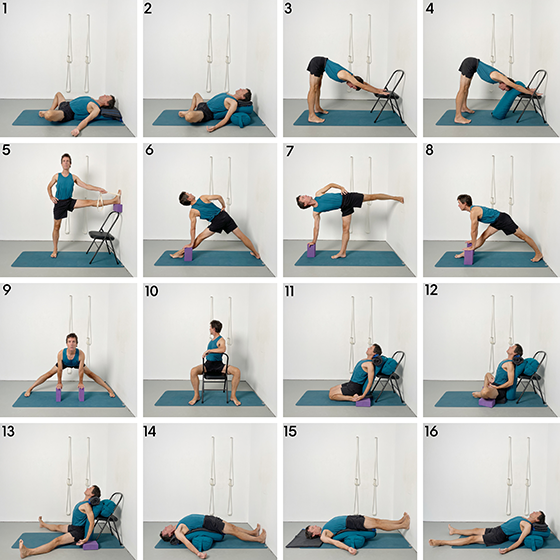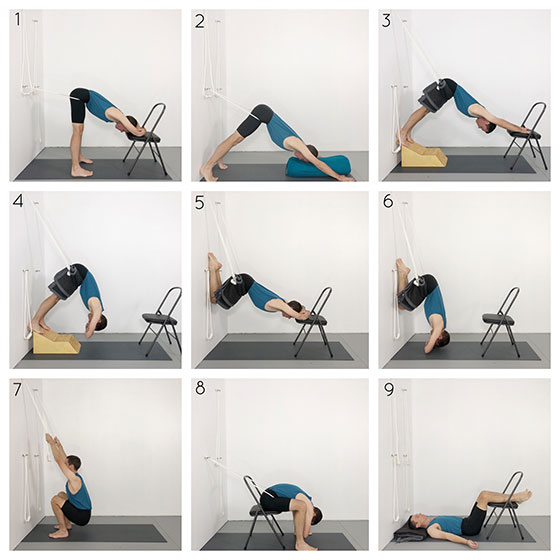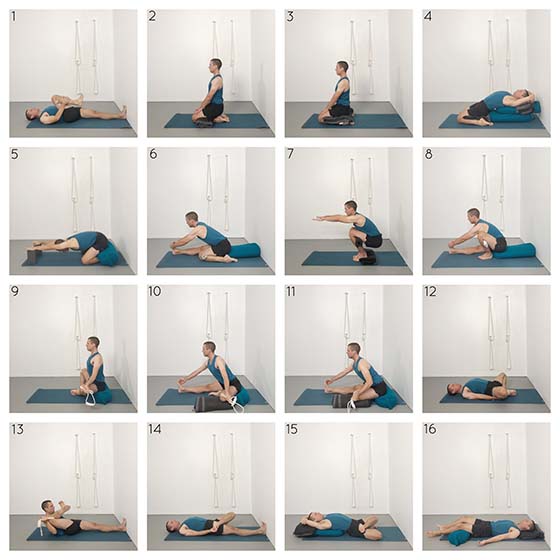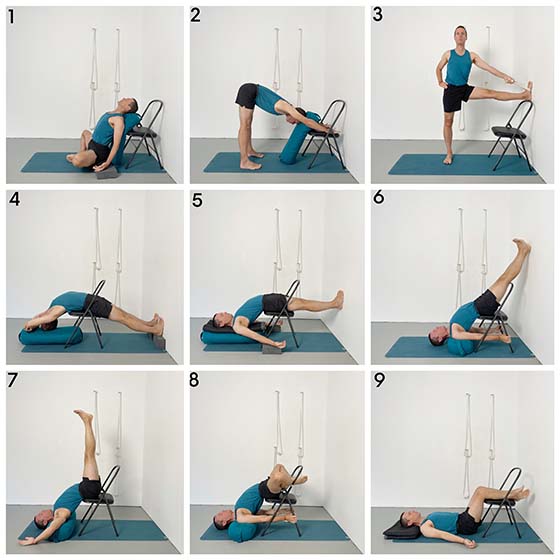Yoga props are essential tools that can significantly enhance your yoga practice, offering support, deepening your experience of each pose, and allowing you to explore new dimensions within your body.
While they’re often introduced to beginners, props are invaluable for practitioners of all levels, providing opportunities for more precise alignment, greater flexibility, and safer progression in challenging asanas.
In this article, we’ll explore how a selection of yoga props—such as blocks, belts, bolsters, ropes, walls, dowelling, blankets, yoga chairs and a viparita dandasana bench—can enrich your yoga practice.
Along the way, we’ll highlight how these props are integrated into Yoga Selection’s classes to help you practice with confidence and understanding.
Explore a World of Online Yoga. Unlimited Access to All Classes and Courses.
Try it Free for 14 days. Cancel Anytime.
Why Use Yoga Props?
Props provide multiple benefits in your yoga practice, including:
- Enhanced Alignment: Helping you achieve and maintain correct alignment, making it easier to access the full benefits of each pose, regardless of your flexibility or experience level.
- Support and Stability: Providing essential support, allowing you to hold poses longer, build strength gradually, and reduce the risk of injury.
- Improved Flexibility: Bringing the floor closer or extending your reach, enabling you to explore challenging movements safely and without strain.
- Accessibility for All: Making yoga poses more accessible for all body types, ages, and abilities, allowing everyone to experience the benefits of yoga regardless of limitations.
The Iyengar Yoga Influence
Many of the yoga prop techniques used today originated from or were popularised by B.K.S. Iyengar, who introduced them as essential tools to make yoga accessible to practitioners of all ages and abilities.
His innovative approach demonstrated that props could help achieve proper alignment, provide support, and allow for a deeper experience of each pose, regardless of physical limitations or flexibility.
While this article focuses on the broader benefits of using props, it’s worth noting that much of what we explore in our classes is rooted in the precision and alignment principles pioneered by Iyengar Yoga.
Yoga Props and Their Benefits
Let’s explore how each prop can enhance your practice, with examples from our Yoga Selection classes.
Yoga Blocks
Yoga blocks are among the most versatile props, providing stability, support, and improved alignment in various poses. They’re great for bringing the floor closer to you, helping to maintain balance, and making challenging movements more accessible.

Quick Tips for Using Blocks
- Place a block under your hand in standing poses like Trikonasana (Triangle Pose) to bring the floor closer and maintain proper alignment.
- Use a block for your front foot in Virabhadrasana II (Warrior Pose 2) to take pressure off your knee and encourage hip opening.
Featured Class: A Full Practice with Blocks
This class is designed for busy schedules, offering a complete practice using just two yoga blocks. You’ll learn how blocks can assist in standing poses, making them more accessible and allowing you to hold poses longer. The sequence includes variations of key inversions, such as a neck-friendly alternative to Sirsasana (Headstand) and a supported Setu Bandha Sarvangasana, along with a range of standing asanas. By using blocks, you’ll experience improved alignment, stability and balance.
Yoga Belts
Yoga belts are ideal for extending your reach, allowing you to explore poses more fully while reducing strain on your muscles, joints, ligaments, tendons, and spine.

Quick Tips for Using Belts
- Use a belt to reach your foot in seated forward bends like Paschimottanasana to avoid straining your lower back.
- Create a loop with the belt and place it around your wrists to mobilise your shoulders and open your chest.
Featured Class: Therapeutic Uses of a Yoga Belt
In this class focused on neck care, you’ll discover how to use a yoga belt to create a therapeutic shoulder harness, which aids in releasing neck tension. The belt helps to guide the shoulders into proper alignment, enabling you to explore poses without straining the neck. Poses that improve the mobility of the upper back, shoulders, and neck are included, along with suggestions for modifying challenging poses, making this class perfect for anyone with neck difficulties.
Bolsters
Bolsters are cushion-like props that provide support and comfort, making them ideal for restorative practices. They allow you to relax more deeply into poses, feel supported in longer held chest opening positions, and help to release tension throughout your body.

Quick Tips for Using Bolsters
- Place a bolster under your knees in Savasana (Corpse Pose) to reduce tension in the lower back.
- Use a bolster under your spine in supported backbends to gently open the chest and shoulders.
Featured Class: Restorative Yoga with Bolsters
This class explores a restorative sequence using a ‘cross bolster’ setup, offering a deeply relaxing experience. By supporting the body, bolsters help you maintain poses for longer, facilitating a gradual release of tension. The sequence includes Upashrayi variations of seated poses, supported standing poses, and breath awareness techniques. Using bolsters encourages relaxation, helps soothe the nervous system, and is especially effective for combating stress.
Yoga Ropes
Yoga ropes, also known as Yoga Kurunta, provide unique support and enable you to explore a wide range of poses with maximised stability and support. They can be particularly useful for supporting inversions and can create a tension releasing traction throughout the spine.

Quick Tips for Using Ropes
- Use ropes to assist in inversions, allowing you to experience the benefits of being upside down without the strain.
- Incorporate ropes to create gentle traction in the lower back.
Featured Class: Relieving Lower Back Pain with Yoga Ropes
In this class, you’ll learn how to use yoga ropes to relieve lower back pain by introducing gentle traction to the spine. Hanging from the ropes counteracts tightness and compression, creating a sense of space throughout the spine. Poses such as Uttanasana (Standing Forward Bend), Adho Mukha Svanasana (Downward Facing Dog), and Malasana (Garland Pose) are practiced with the support of ropes. For a more comprehensive exploration, Yoga Selection offers a four-class course that teaches effective techniques for using wall ropes, guiding you from beginner to advanced levels.
The Wall
The wall is a simple yet highly effective prop that offers support, reinforces balance and clarifies alignment. It can be used to gain a deeper understanding of body mechanics, preserve energy levels, and enhance alignment across a variety of poses.

Quick Tips for Using the Wall
- Use the wall to support your balance and preserve energy in poses like Ardha Chandrasana (Half Moon Pose).
- Practice inversions against the wall to build confidence and strength without the fear of falling.
Featured Class: Using the Wall for Standing Poses
This class demonstrates how to incorporate a wall into your home practice, focusing on standing poses with front and back body support. Using the wall helps stabilise posture, improve alignment, and enhance spinal mobility, making it perfect for times when you feel fatigued or are recovering from illness. You’ll discover new dimensions in familiar poses and learn how the wall can aid in maintaining balance and alignment.
Dowelling (Wooden Rods)
Dowelling is an often-overlooked but highly effective prop that helps with alignment, posture correction, and shoulder mobility. By holding a dowel behind the back, you can improve leverage into tight shoulders and enhance your ability to mobilise the upper back.

Quick Tips for Using Dowelling
- Hold a dowel behind your back to encourage chest opening in standing poses.
- Use dowelling as a guide for proper shoulder alignment in poses like Parsvottanasana (Intense Side Sttretch).
Featured Class: Standing Poses with Dowelling
This class uses dowelling to explore standing poses, offering unique methods to improve alignment. Holding the dowel behind your back helps create space in the shoulders and spine, making it especially useful for those with upper back restrictions, neck issues, or kyphosis. This class provides a fresh approach to traditional standing asanas, helping you experience them with greater awareness and control.
Blankets
Blankets are versatile props with therapeutic applications, providing cushioning, support, and warmth. They are particularly beneficial for individuals with knee pain or those seeking lower back support.

Quick Tips for Using Blankets
- Fold a blanket under your knees in poses like Janu Sirsasana (Head to Knee Pose) for extra support and injury prevention.
- Use a blanket to elevate your hips in seated poses like Paschimottanasana (Seated Forward Bend) for improved spinal support.
Featured Class: Forward Bends and Knee Care with Blankets
In this class, blankets are featured prominently to provide support in poses that are often challenging for people with knee difficulties. Whether folded or rolled, blankets help reduce pressure on the knees, distribute weight evenly, and prevent strain, allowing you to fully engage in forward bends with confidence. This therapeutic approach helps protect the knees while enabling you to explore the fundamental techniques of forward bending.
Yoga Chair
The yoga chair is a versatile prop that offers support and stability, making it ideal for both restorative practices and more advanced poses. It helps you maintain alignment whilst exploring deeper variations, and holding poses for longer durations.

Quick Tips for Using a Yoga Chair
- Use a chair for supported backbends, allowing you to gently open the chest without strain.
- Incorporate a chair into seated forward bends to maintain alignment and deepen the stretch.
Featured Class: Restorative Chair Yoga for Chest Opening
This class features a chest-opening restorative sequence using a chair, including variations of Supta Baddha Konasana, Viparita Dandasana, Viparita Karani, and Setu Bandha Sarvangasana. The chair provides support, allowing your chest to open fully and your diaphragm to move freely. This class is perfect for times of stress or low energy, as the chair helps create a supported, restorative experience.
Viparita Dandasana Bench (Backbender)
The Viparita Dandasana bench, or backbender, is a specialised prop designed to support and enhance backbend practices. It provides a stable and safe structure for exploring deeper backbends, making it ideal for practitioners looking to improve flexibility, chest opening, and overall spinal mobility. It is also great for restorative chest opening and can also be used as an alternative for inversions.

Quick Tips for Using the Backbender
- Use the bench to gently support the spine in viparita dandasana, allowing you to relax and open the chest without strain.
- Adjust the bench to suit your height and comfort level, ensuring balanced alignment in each pose.
Featured Class: How the Viparita Dandasana Bench Is Used in Practice
This class features a sequence centered around using the Viparita Dandasana bench, guiding you through the basics of how to use this support for practicing Viparita Dandasana. The class offers troubleshooting tips for common problems and suggestions on creating balanced alignment, allowing you to adjust the pose to suit your individual needs. Once the foundational use is covered, the class progresses to more active ways of using the bench, expanding your backbend options with variations of Dwi Pada Viparita Dandasana, Urdhva Dhanurasana, and Urdhva Mukha Svanasana (Upward Facing Dog Pose). This session is beneficial not only for exploring Viparita Dandasana but also serves as a balanced chest-opening sequence on its own.
FAQ: Common Questions about Yoga Props
Q: Are yoga props only for beginners?
A: No, props are valuable tools for practitioners of all levels. They help deepen poses, improve alignment, and make challenging asanas more accessible. Advanced practitioners use props to refine their practice, reach new levels of depth, and explore more complex poses safely.
Q: What if I don’t have all the props at home?
A: You can often find alternatives using items around your home. A thick book can substitute for a yoga block, a scarf or belt can replace a yoga strap, and cushions or pillows can be used instead of a bolster. A sturdy chair and a clear wall space work perfectly in place of specialised yoga chairs and walls.
Q: How do props help with alignment?
A: Props provide feedback and support, helping you understand where your body should be in each pose. For example, using a block under your hand in Trikonasana (Triangle Pose) helps you maintain a straight line from your shoulder to your wrist, preventing you from collapsing in the pose and ensuring proper alignment.
Q: Are there any specific safety considerations when using props?
A: Yes, always make sure your props are stable and secure. If you’re using items from around the house, ensure they’re sturdy enough to support your weight. When using yoga ropes or the wall, make sure they’re properly anchored, and never force yourself into a pose just because you have a prop. Always listen to your body and use props as tools to support, not push, your practice.
Q: Can props help with injury recovery or pain management?
A: Absolutely! Props are excellent for therapeutic purposes, allowing you to modify poses and reduce strain on vulnerable areas. For example, using a bolster can support your spine in restorative poses, and a belt can help you maintain proper alignment without overextending your muscles. If you’re recovering from an injury, props can help you gradually build strength and flexibility while protecting the injured area.
Q: How can I make my yoga practice more challenging using props?
A: Props aren’t just for making poses easier—they can also add intensity and challenge. For example, placing a block between your thighs in poses like Utkatasana (Chair Pose) helps engage the inner thighs more deeply. Using a belt in poses requiring shoulder extension can create resistance, helping you build strength and flexibility.
Q: Why are props so integral to Iyengar Yoga?
A: Props are an essential part of Iyengar Yoga because they allow practitioners to experience the full benefit of each pose, regardless of their flexibility, strength, or experience level. They help maintain alignment, support the body, and make challenging poses accessible, ensuring that everyone can practice yoga safely and effectively.
Q: Can I practice yoga without props if I’m traveling or don’t have access to them?
A: Yes, you can practice yoga without props, but they can make certain poses more accessible or comfortable. If you’re traveling, consider bringing lightweight props like a yoga belt or foldable blanket. You can also get creative with what’s available in your environment, using towels, books, or even walls and chairs to support your practice.
Q: How do I know which prop to use for a particular pose?
A: This often comes down to experience and the guidance of a teacher. Props are typically used to enhance alignment, provide support, or make a pose more accessible. For example, if you find it difficult to reach the floor in a forward bend, a block can bring the floor closer to you. In our Yoga Selection classes, you are guided through the correct use of props for each pose, helping you understand how and when to incorporate them into your practice.
Conclusion: Unlocking Your Potential with Yoga Props
Yoga props are powerful tools that can enhance your practice, helping you to connect more deeply with your body. They offer a pathway to greater understanding, flexibility, and alignment, whether you’re a beginner or an experienced practitioner. As you explore the use of props, Yoga Selection provides classes designed to guide and support you on this journey.
If you’d like to learn more about integrating props into your practice, explore our classes at Yoga Selection, where you’ll find detailed guidance tailored to your needs.
Explore a World of Online Yoga. Unlimited Access to All Classes and Courses.
Try it Free for 14 days. Cancel Anytime.
Share:
See Related Blog Posts:
